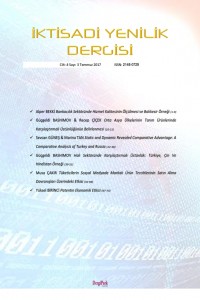Öz
Modern bilgi tabanlı günümüz
dünyasında yaşanan hızlı teknolojik gelişmeler ve bunun beraberinde getirdiği
kısalan yenilik süreçleri, bilimin ve ar-ge’nin ekonomik, toplumsal ve
teknolojik önemini daha da artırarak bilgiyi en önemli rekabet faktörüne dönüştürmüştür.
Bilgi bazlı toplumda yenilik faaliyetleri ve elde edilen bilginin
içselleştirilerek faydaya dönüştürülmesi fikir sahiplerine süreli tekel hakkı
vererek rekabette avantaj sağlamaktadır.
Ekonomik büyüme açısından ar-ge harcamalarının artırılması, bilgi ve
yenilik dostu işletme kültürünün oluşturulması yanında elde edilen fikirlerin
korunması önem arz etmektedir. İşletmeler piyasada rekabet gücünü korumak,
ekonomik başarılarını devam ettirebilmek için yeni fikirlere ve yeniliklere
ihtiyaç duyarlar. Söz konusu yeni fikirlerin ve yeniliklerin buluş sahipleri
tarafından koruma altına alınmalı ve piyasa ürünü olarak değerlendirilmesine
imkân verilmelidir. Bu kapsamda patent hakkı yeniliklerin korunmasında ve
taklit ürünlerin piyasaya çıkışının engellenmesinde önemli işleve
sahiptirler. Bu çalışmada, fikri
mülkiyetin önemli araçlarından olan patent konusu ele alınmakta ve yeni fikir
ve yeniliklerin korunmasının ekonomik etkileri tartışılmaktadır.
Anahtar Kelimeler
Kaynakça
- 551 Sayılı Patent Haklarının Korunması Hakkında Kanun Hükmünde Kararname
- Dhar, B. ve Rao, C. N. (2002). International Patent System: An Empirical Analysis, Research and Information System For the Non-Aligned and Other Developing Countries, India Habitat Centre, New Delhi.
- Langinier, C ve Moschini, G. (2002). The Economics of Patents: An Overview. www.card.iastate.edu, (Erişim tarihi: 20.05.2017)
- Lehman, B. A. (1999). Industrial Property as an Engine of Global Economic Growth. Presented in the Symposium on the Management of Patent and Trademark Offices in Countries in Transition, Republic of Moldova.
- Rapp, R. T. ve Rozek, R. P. (1990). Benefits and Costs of Intellectual Property Protection in Developing Countries. Journal of World Trade, 24-5.
- Scherer, F. M. (1980). Industrial Market Structure and Economic Performances. Second Edition, Chicago: Rand-McNally.
- Schmookler, J. (1966). Invention and Economic Growth. Cambridge, Massachusetts: Harward University Press.
- Yalçıner, U. G. (2000). Sınai Mülkiyetin İlkeleri. Ankara: Metal Ofset.
- OECD. (2017). Patents, Innovation and Economic Performance: OECD Conference Proceedings. http://www.oecd.org/sti/sci-tech/34256876.pdf (Erişim tarihi: 11.06.2017)
- WIPO. (2016) World Intellectual Property Indicators. www.wipo.int/edocs/pubdocs/en/wipo_pub_941_2016.pdf ((Erişim tarihi: 11.06.2017)
Öz
Rapid
technological developments and the shortened innovation processes living in
today's knowledge-based world transform information into the most important
competitive factor by further increasing the economic, social and technological
importance of science and R & D. Innovative activities in the
knowledge-based society and the transformation of the acquired knowledge into
the benefits of internalization provide a constant advantage by giving the
intellectuals a constant monopoly. It is important to protect the ideas obtained
as well as the expenditure of R & D in terms of economic growth and to form
knowledge and innovation-friendly business culture. Businesses need new ideas
and innovations to keep their competitive power and sustain their economic
success in the marketplace. The given new ideas and innovations should be
protected by inventors and evaluated as market products. In this context,
patent right has an important role in protecting the innovations and preventing
the imitation products from reaching the market. In this study, patent concept
which is one of the important tools of intellectual property and economic
effects of preserving new ideas and innovations are discussed.
Anahtar Kelimeler
Kaynakça
- 551 Sayılı Patent Haklarının Korunması Hakkında Kanun Hükmünde Kararname
- Dhar, B. ve Rao, C. N. (2002). International Patent System: An Empirical Analysis, Research and Information System For the Non-Aligned and Other Developing Countries, India Habitat Centre, New Delhi.
- Langinier, C ve Moschini, G. (2002). The Economics of Patents: An Overview. www.card.iastate.edu, (Erişim tarihi: 20.05.2017)
- Lehman, B. A. (1999). Industrial Property as an Engine of Global Economic Growth. Presented in the Symposium on the Management of Patent and Trademark Offices in Countries in Transition, Republic of Moldova.
- Rapp, R. T. ve Rozek, R. P. (1990). Benefits and Costs of Intellectual Property Protection in Developing Countries. Journal of World Trade, 24-5.
- Scherer, F. M. (1980). Industrial Market Structure and Economic Performances. Second Edition, Chicago: Rand-McNally.
- Schmookler, J. (1966). Invention and Economic Growth. Cambridge, Massachusetts: Harward University Press.
- Yalçıner, U. G. (2000). Sınai Mülkiyetin İlkeleri. Ankara: Metal Ofset.
- OECD. (2017). Patents, Innovation and Economic Performance: OECD Conference Proceedings. http://www.oecd.org/sti/sci-tech/34256876.pdf (Erişim tarihi: 11.06.2017)
- WIPO. (2016) World Intellectual Property Indicators. www.wipo.int/edocs/pubdocs/en/wipo_pub_941_2016.pdf ((Erişim tarihi: 11.06.2017)
Ayrıntılar
| Konular | İşletme |
|---|---|
| Bölüm | Makaleler |
| Yazarlar | |
| Yayımlanma Tarihi | 18 Temmuz 2017 |
| Gönderilme Tarihi | 6 Haziran 2017 |
| Kabul Tarihi | 1 Temmuz 2017 |
| Yayımlandığı Sayı | Yıl 2017 Cilt: 4 Sayı: 3 |


